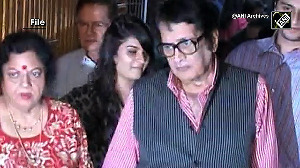Prime Minister Narendra Damodardas Modi on Monday, July 4, 2022, said the history of the country's freedom struggle was not about a few years or some people, but was about the sacrifice from every nook and corner of the country.

In his address after unveiling a 30-feet bronze statue of Alluri Sitarama Raju, Modi said the legendary freedom fighter's 125th birth anniversary and the centenary of the Rampa Rebellion will be celebrated throughout the year.
Alluri led the Rampa rebellion, which was launched in 1922. He is referred to as Manyam Veerudu (Hero of the Jungles) by the local people.
Modi said Alluri Sitarama Raju involved himself in the country's fight for Independence early, dedicating himself for Adivasi welfare and the country and was "martyred" at a young age.
Alluri, Modi added, "was a symbol of India's culture, Adivasi identity and values."
Modi said no one can stop from making a 'New Bharat' when our youth, tribals, women, dalit and the downtrodden lead the country.
"I bow to the great freedom fighters born in Andhra Pradesh. We have not forgotten our freedom fighters, we will not forget and we will move forward by taking inspiration from them," the prime minister said and recalled icons from the state including Pingali Venkayya, "who prepared our national flag" and Potti Sriramulu.
Modi felicitated Alluri Srirama Raju, the freedom fighter's nephew, and Bodi Dora, the son of Alluri's close lieutenant Mallu Dora.
Sitarama Raju, also referred to by his surname Alluri, was born on July 4, 1897, at Pandrangi village in the then Visakhapatnam district.
According to history, the regular patriotic discourse during the freedom struggle had a strong influence on Alluri since his childhood. Following his father's death, his schooling got disrupted and he went on a pilgrimage and toured the western, northwestern, north and north eastern parts of India during his teens.
The socio-economic conditions in the country under the British regime, particularly in the tribal areas, deeply moved him.
During those journeys, he met revolutionaries in Chittagong (now in Bangladesh). Alluri then made up his mind to build a movement against the British. He organised the local Adivasis in the forest areas along Visakhapatnam and East Godavari districts into a potent force to launch a frontal attack.
Thus was born the Rampa Rebellion or the Manyam Uprising in the Rampachodavaram forest area in the erstwhile East Godavari district, which rattled the British.
Using the Adivasis' traditional weapons -- bows and arrows and spears -- Alluri spearheaded attacks on the British and became a thorn in their flesh.
He realised that traditional weaponry was no match against the heavily armed British forces and planned to snatch the enemy's own weapons.
The famed attack on the Chintapalli police station on August 22, 1922, with over 300 revolutionaries, was the first in the series, which ended in a haul of firearms.
The sheer audacity of Alluri in warning, in advance, the police of the date and time of the attack left the British stunned.
He enlisted the booty and signed the station diary after the attack, making it his hallmark. He led similar attacks later on the Krishnadevi Peta and Raja Ommangi police stations. The revolutionaries under Alluri's leadership snatched weapons and armoury in all such attacks.
A large contingent of reserve police personnel from Visakhapatnam, Rajahmundry, Parvatipuram and Koraput was rushed to these areas led by British officers and, in the skirmish that ensued, two -- Scot and Heiter -- were killed by the revolutionaries on September 24, 1922, and several others wounded.
Agency Commissioner J R Higgins had announced a prize of Rs 10,000 on Alluri's head and Rs 1,000 each on his close lieutenants Gantam Dora and Mallu Dora. The British deployed hundreds of soldiers from the Malabar Special Police and the Assam Rifles, led by top officers, to crush the movement.
Alluri won the grudging admiration of the British as a formidable guerrilla tactician. Unable to contain the Manyam uprising, the British government deputed T G Rutherford as the new commissioner in April 1924 to quell the movement.
Rutherford resorted to violence and torture to know the whereabouts of Alluri and his key followers. It was a relentless chase by the British forces that cost them an overall Rs 40 lakh.
Unable to stand the brutal repression against the tribals, Alluri finally gave himself up and was martyred on May 7, 1924.
He lived only for 27 years, but close to a century after his martyrdom, the Telugus continue to revere and worship Alluri.
Former AP chief minister N Chandrababu Naidu wrote a letter to Prime Minister Modi requesting that a statue of Alluri be installed in Parliament. Naidu recalled that a decision to install Alluri's statue in Parliament was taken by the then NDA government led by Atal Bihari Vajpayee but was not implemented due to change of government.
'It will now be apt,' Naidu wrote, 'to install the legendary freedom fighter's statue in Parliament in his 125th year of birth.'











 © 2025
© 2025